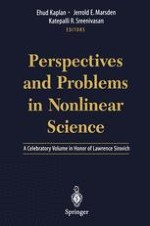2003 | OriginalPaper | Chapter
Boolean Dynamics with Random Couplings
Authors : Maximino Aldana, Susan Coppersmith, Leo P. Kadanoff
Published in: Perspectives and Problems in Nolinear Science
Publisher: Springer New York
Included in: Professional Book Archive
Activate our intelligent search to find suitable subject content or patents.
Select sections of text to find matching patents with Artificial Intelligence. powered by
Select sections of text to find additional relevant content using AI-assisted search. powered by
This paper reviews a class of generic dissipative dynamical systems called N-K models. In these models, the dynamics of N elements, defined as Boolean variables, develop step by step, clocked by a discrete time variable. Each of the N Boolean elements at a given time is given a value which depends upon K elements in the previous time step. We review the work of many authors on the behavior of the models, looking particularly at the structure and lengths of their cycles, the sizes of their basins of attraction, and the flow of information through the systems. In the limit of infinite N, there is a phase transition between a chaotic and an ordered phase, with a critical phase in between. We argue that the behavior of this system depends significantly on the topology of the network connections. If the elements are placed upon a lattice with dimension d,the system shows correlations related to the standard percolation or directed percolation phase transition on such a lattice. On the other hand, a very different behavior is seen in the Kauffman net in which all spins are equally likely to be coupled to a given spin. In this situation, coupling loops are mostly suppressed, and the behavior of the system is much more like that of a mean field theory. We also describe possible applications of the models to, for example, genetic networks, cell differentiation, evolution, democracy in social systems and neural networks.
